Why tire pressure at Paris-Roubaix is cycling’s most-guarded secret
This article originally appeared on Velo News
Pffffft -- that’s the sound of Lizzie Deignan releasing air from her tires minutes before the start of the inaugural edition of Paris-Roubaix Femmes in 2021.
Trek-Segafredo staffers and sport directors looked on with worry. In recon rides across the cobbles just days before the race, Deignan was pushing the lower limit of what the tire manufacturer Pirelli and the team’s fleet of specialists were suggesting.
Like any racer, she had the final word on her preferred tire pressure. And she was right.
The British star floated across the slushy and muddy pave to carve her name into the history books as the first winner.
“Lizzie tried super-low pressure on recon, and even the rep from the tire manufacturer said, ‘I think we are now on the limit,” Trek-Segafredo’s technical support manager Glen Leven told VeloNews. “She stopped, and let more air out of the tire.
“Every was super-nervous, but she raced with the pressure she wanted, and it made for a great victory.”
Also read:
Paris-Roubaix Femmes: Alison Jackson scores dazzling sprint victory as breakaway fends off favorites
In 2021, Pirelli officials later confirmed to VeloNews that Deignan won on stock Pirelli P Zero TLRs tubeless clinchers in 30mm on “around” 2.7 bar (39 PSI).
The real number? Only Deignan and perhaps a few insiders will ever know.
Why are pros so secretive?
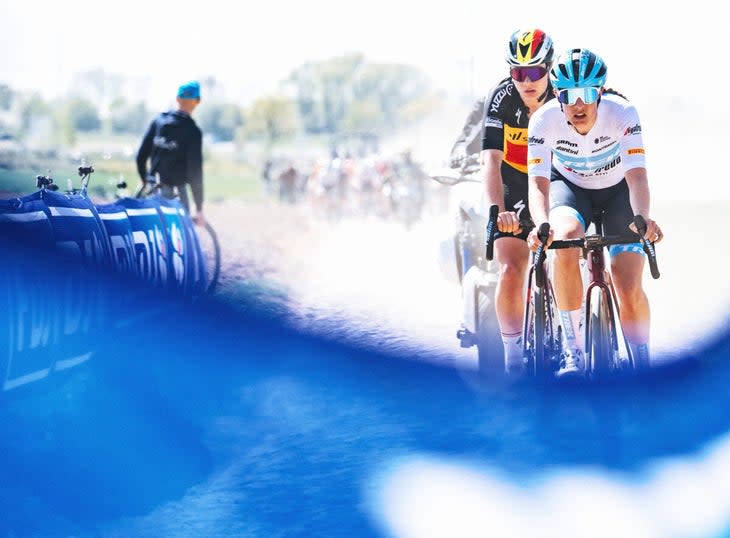
Ask a pro what tire pressure they’re racing this weekend, and the gambit runs from, “whatever the mechanic says is right,” to “well, I am not going to tell you.”
Tire pressure at Paris-Roubaix is part of the secret sauce that makes a winning ride.
It’s akin to Chris Froome being hesitant to give up his power numbers on Mont Ventoux a decade ago. That inside information, often extracted after long hours of training and testing, is not a public commodity.
What rivals don’t know cannot be used by rivals to beat you. Riders and teams might share more information after the race, but no one is going to tell you before.
“My tire pressure for Sunday? If I give it to you, I will have to kill you,” Luke Rowe told L’Equipe this week after a recon ride. “It’s the peloton’s best-kept secret.”
A few PSI here and a sliver of a bar there, does it really matter?
Yes, it matters.
The hunt for the perfect tire pressure is the last bastion of superstition left in cycling.
Back in 2018, Niki Terpstra was caught red-handed checking the tire pressure of top rival Peter Sagan’s bike after Sagan relegated him to third place.
LA FOTO de la #ParisRoubaix
Terpstra mirando la presion que habia llevado Sagan en carrera. pic.twitter.com/TOWB30yeFl
-- Alex Lebron (@AlexLebron) April 9, 2018
Science and tech has taken over just about every corner of the sport, but there’s a personal sense of feel and confidence with Roubaix tire pressure that still holds firm.
“It's pretty clear it's a secret,” Leven said. “Everyone is doing their own testing, and the riders decide to race on what they feel the best with.
“It's a secret of what pressure they use. Some riders prefer ride super low, so if you win, you did the right choice,” he said. “It's a big secret. Nobody talks about tire pressure in Roubaix anymore.”
At least not publicly.
Roubaix’s Holy Grail: Finding the perfect balance
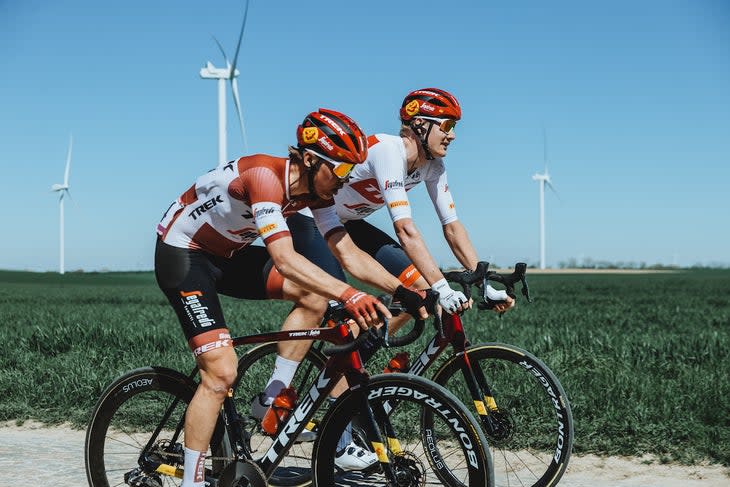
That rubber-on-road contact point between man or woman, machine, and the cobblestones is a multimillion-dollar, multi-year obsession for many inside the rolling circus of bike racing.
Like every team racing this weekend, Trek-Segafredo spends weeks and months testing different wheels and tire combination. New equipment for the upcoming spring campaign is usually rolled out in the fall.
Teams will hit out on the Roubaix cobbles a few times over the winter, and make the final recon rides in the days before the big races.
“All the riders like to play around with the pressure,” said Leven, who heads up all the bikes and racing material used by the men’s and women’s team at Trek-Segafredo. “That’s why the recon is so important. Even if you do testing in February, you have the current conditions and feelings on the bike that are different in April.”
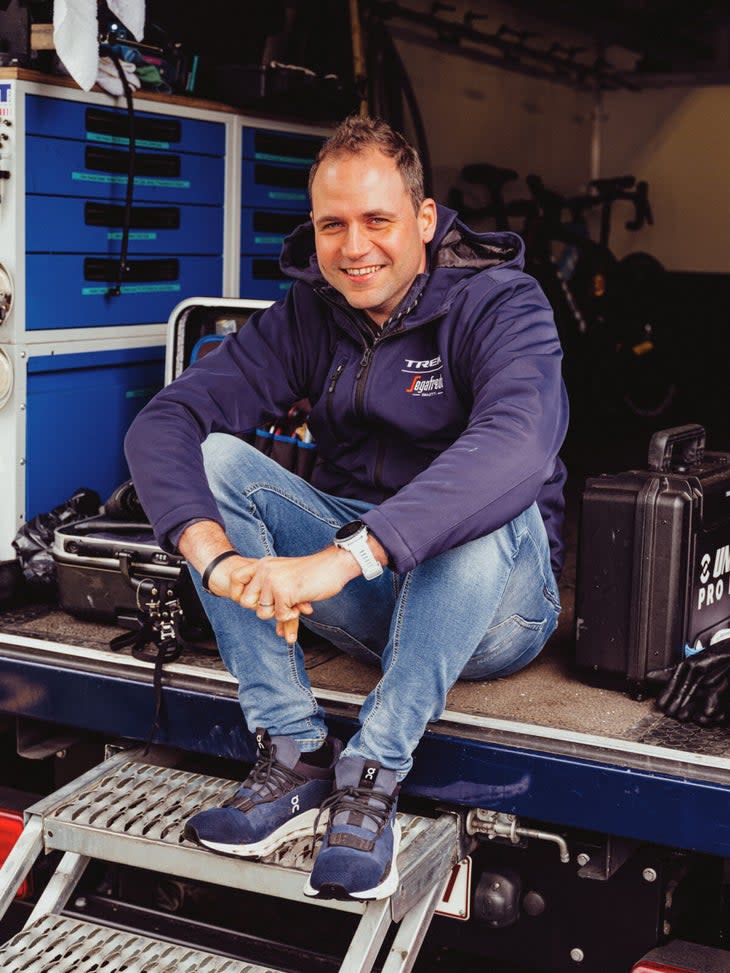
And in many ways, this weekend’s races at Paris-Roubaix Femmes and Paris-Roubaix represent the Formula 1 of bike racing.
The start areas of both races will be swarming with bike geeks and tech reporters scooping out the latest innovations. What shows up at Roubaix almost always ends up on shelves in local bike shops.
The races are the culmination of weeks, months, and years of preparation to get everything just right on a day when everyone knows when something is bound to go wrong.
No singular race day of the year generates as much attention to detail as Paris-Roubaix.
“Cycling today is a kind of Formula 1, without an engine,” Leven said. “There is more and more testing and research going into cycling, to take the last watts and gains out of the bike, and to be as fast as possible on race. That’s certainly true at Roubaix.”
An array of new bikes, saddles, wheels, brakes, triple-tape on the handlebars, suspension headsets, and even the occasional wacky shock system are unveiled each year in the endless quest to tame the cobblestones.
✅ Adjusting tire pressure, maybe more useful than on any other race!
✅ Verification de la pression des pneus, un geste habituel mais peut etre encore plus crucial sur #ParisRoubaixFemmes ! pic.twitter.com/sY8K3nZ3PE
-- Paris-Roubaix Femmes avec Zwift (@RoubaixFemmes) April 8, 2023
And a key piece of the bike puzzle is tires, tire selection, and the ever secret alchemy of tire pressure.
Of course, there is a known range of tire pressure for Sunday’s men’s race. Women’s racing is tapping into the decades of testing and data as it applies similar lessons to Saturday’s Paris-Roubaix Femmes.
The decades-long trend is wider tires at lower pressures.
The general range for men is 3.5-5 bar (51-73 psi) for tubeless, and 4.5-5.5 bar (65-80 psi) for tubulars, according to VeloNews contributor Lennard Zinn. Those numbers also vary greatly based on weight, so the women race even lower pressure.
“I was testing 2.5, 2.7 bar, which is quite low. The average cyclist would think you would have a flat tire. You really need it on these cobbles. You will have a lot more energy by having a more comfortable ride,” Grace Brown (FDJ-Suez) told VeloNews‘ Sadhbh O’Shea after a recon ride this week. “You finish the race more fresh with lower tire pressure, and I’ve ridden the course with higher tire pressure, and I’ve felt wrecked.”
What that exact number will be on race day is like asking someone to give you the access codes to their Bitcoin wallet.
“I’d say we run about a half-bar less in Roubaix than what we run in Flanders, which is about one-third less than normal,” said EF Education-EasyPost mechanic Jacobus Johannes Steyn, before fidgeting in his seat. “And that’s all we’re saying.”
Why is tire pressure so important?
A puncture, lost grip on a corner, or inefficiency on the flats can spell the difference between winning and losing.
There’s a thin line between victory and agony at Paris-Roubaix, and it’s measured in millimeters of contact between the bike and the ground.
High-tech answer to an old question
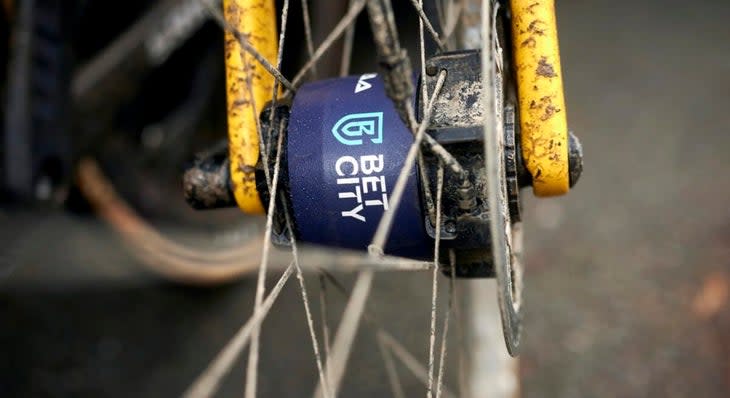
The latest advance in the treasure hunt for the perfect tire pressure will play out this weekend.
For the first time, select riders from Team DSM and Jumbo-Visma will be running tire-pressure regulators in the men’s race that will allow riders to adjust tire pressure during the race.
The logic goes like this: only about one quarter of Paris-Roubaix is contested on the cobbles. A slightly higher tire pressure on the pavement will help with efficiency, and a lower tire pressure on the cobbles will aid in grip and cornering.
“We always try to find new things and it's a huge innovation,” said Van Aert, who won’t be racing with the system. “It's easy to explain if you can have lower pressure on the cobbles and still have the normal pressure you're used to on the tarmac, it's a big benefit for all of the accelerations in between.”
The equipment’s been tested in labs and in trials on the road, and now it faces the crucible of the harsh race conditions Sunday.
Advocates of the new technology argue that extra weight from the hub-mounted regulators will be more than compensated by watt-savings on the road.
Everyone is waiting to see the verdict. If they’re deemed successful, expect wider application in future editions of Roubaix.
"It's of course something that can maybe help us, it's a huge advantage,” Van Aert said. “We don't want to give all of the secrets already.”
Van Aert is keeping the cards close to his chest.
A few tubular holdouts
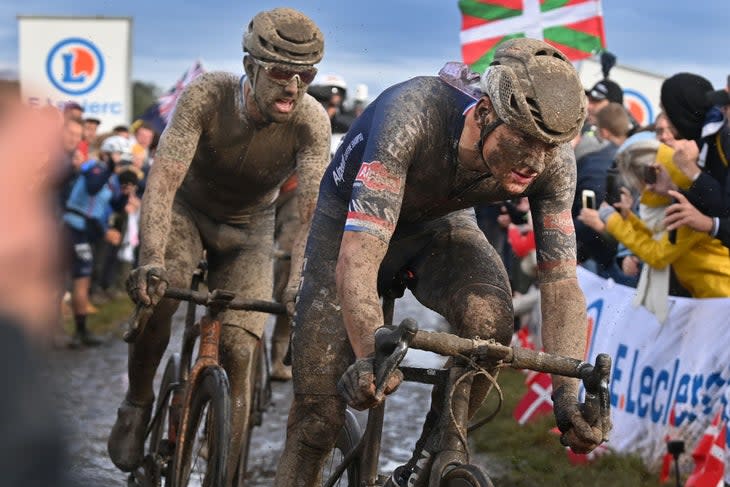
The transition to tubeless is now almost complete at Paris-Roubaix. Nearly every team raced tubeless over the weekend.
Even Mathieu van der Poel, who rode tubular in 2021 to finish third, will race tubeless Sunday.
The upsides of tubeless are many, especially for a puncture-prone race like Roubaix. Tubeless tires are not only more aerodynamic they also allow for even lower tire pressures.
Tubeless are less prone to pinch flats, and mechanics will be using liners in the tires that maintain the effect of about 1.5 bars in the tire even in the most catastrophic of punctures. That allows riders to keep moving instead of standing on the side of the road.
“We still use tubular, and our riders can decide what they want to ride,” Leven said. “They can race on what they feel the best on. Even if we show them that tubeless is the best option based on the testing and science, but if riders feel more comfortable on a tubular, we support this decision.”
Some riders will still be using tubulars this weekend. Why? It goes back to that personal preference and the ever-elusive “feel.”
Tubulars feature softer sidewalls and provide a much smoother ride over the punishing cobbles. Tubeless have a stiffer sidewall, so it’s a tradeoff between the more aerodynamic tubeless and the softer riding tubular.
With hours of jarring roads ahead of them, some pros still prefer tubular.
Back in 2009, for example, riders were racing on 27mm tubulars, with Tom Boonen racing with 4.1 bar (59.5 PSI) on his front tire, and 4.3 bar (62.4 PSI) on his rear, or at least that’s what officials told VeloNews back then.
Riders started experimenting with wider tubular tires and lower tire pressures, but it wasn’t until the last few years that clincher tubeless have taken hold of the peloton.
In fact, the 2021 edition was a milestone for Roubaix, with both Deignan and Sonny Colbrelli winning Roubaix on tubeless setups for the first time.
According to VeloNews contributor Lennard Zinn, Colbrelli won on 32mm tubeless running with pressure between 3 to 4 bars (43.5-58 PSI), while his 10th-place teammate Heinrich Haussler raced the same 32mm tubeless GP5000S tires, except at 2.6 and 2.7 bar (38-39 PSI).
That’s nearly half the tire pressure the peloton was racing on 15 years ago.
Less is more on the Roubaix cobbles
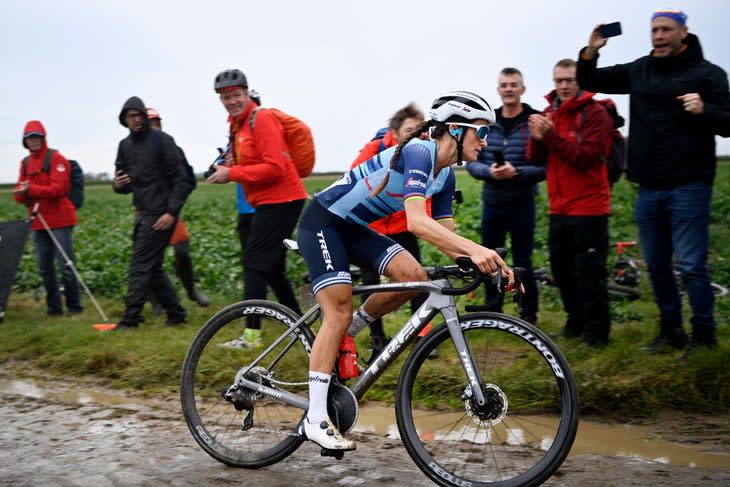
There are many factors that go into determining the right tire pressure.
A rider’s weight, racing style, experience, expectations, and personal preference on the road and cobbles are all deciding factors.
Race-day conditions, whether it’s dry or wet, are other obvious data points. It’s just as much of an art as it is science.
Testing of tires starts months before Roubaix. In fact, Trek’s Leven said data from this weekend’s races will be used to prepare tires for the 2024 editions.
Leven, a former bike mechanic who now organizers all the “on-bike” race tech for the two sprawling teams, has been on the front line in the hunt for the latest, lightest, and fastest.
Leven said it’s during tire testing and recon riders when the magic happens.
“You try different stuff, different tires, different sizes of wheels, liner and no liner, different quality of sealant, different bikes,” he said. “We do it so the riders get the feeling with the different stuff we are using and the options, and they can pick the one they want.”
It’s interesting to watch the evolution from tubular to tubeless. Two decades ago, everyone rode tubular because, well, that’s all there was.
Mechanics would hand-build the wheels and cure tires in a dark, damp garages for months and even years to find the right suppleness and elasticity for Roubaix.
' #ParisRoubaix #LaReineDesClassiques #Cycling #Cyclisme #LEnferDuNord #Roubaix#120emeEdition
♀️♂️♀️♂️♀️♂️♀️♂️♀️Emils Liepins,coureur de Trek-Segafredo,a l’arrivee de l’edition 2021. (Gruber Images) via @lequipe pic.twitter.com/LiozaBN6zP
-- Depecker (@XavierGil_MPils) April 8, 2023
These days, carbon-fiber wheels are pre-made and shipped to mechanics, and the clincher tubeless tires are pulled right out of the box and mounted on the wheel at the team hotel.
Of course, the wheel sets are still built out with foam inserts and sealants, but the process is not as labor-intensive as in the past.
“Now we pull the tubeless tires right out of the box and mount them,” said EF’s Steyn, who is part of three mechanics dedicated to the classics program. “The wheels come prepared as well. They’re manufactured in Taiwan and built in Italy. We still get them race-ready.”
Less is more at Paris-Roubaix.
The idea is to float like a butterfly over the pave, not get stung into submission.
Whoever wins this weekend knows they will have made the right tire pressure choice, just don’t expect them to tell you the real number.
For exclusive access to all of our fitness, gear, adventure, and travel stories, plus discounts on trips, events, and gear, sign up for Outside+ today.

